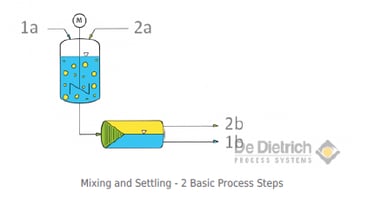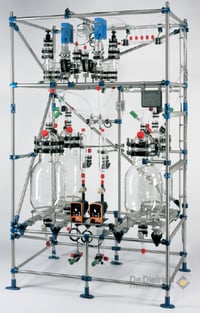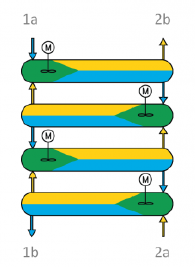Mixer-Settlers: A Top Choice for Liquid/Liquid Extraction Processes
.jpg?width=331&height=233&name=Mixer%20settler%20(1).jpg) Mixer-settlers are commonly used for liquid/liquid solvent extraction applications that typically operate in continuous mode. Their name is derived from the two stages that make up the process – the first stage that mixes the two liquid phases together to accomplish mass transfer, and the second stage that uses gravity to naturally separate and settle the phases.
Mixer-settlers are commonly used for liquid/liquid solvent extraction applications that typically operate in continuous mode. Their name is derived from the two stages that make up the process – the first stage that mixes the two liquid phases together to accomplish mass transfer, and the second stage that uses gravity to naturally separate and settle the phases.
Mixer-settlers are not a new technology, but they are still a popular choice, even in the most modern plants. They are especially practical for difficult extraction processes because of their reliability, flexibility, and ability to handle high volumes of product. By “difficult extraction processes” we mean operations that involve products with challenging characteristics such as:
- difficulty dispersing
- high interfacial tension
- large phase density differential
By connecting several mixer-settler stages in series and arranging for the phases to flow counter-current to each other, a train of mixer-settlers can be adapted to handle the separation problems requiring more than 1 theoretical stage of separation.
Basic Mixer-Settler Operation Principles
The mixer and settler are essentially two separate components that are integrated to act as one system. In the simplest of arrangements, the mixer vessel contains an agitator that is in contact with the feed solution (heavy phase) and solvent (light phase) to thoroughly mix the phases (if more contact time is required, the feed rate is decreased, or multiple mixer-settlers/stages are employed). From there, a pumping turbine transfers the emulsion to the settler. The settler, which is located downstream from the mixer to allow the heavy phase and light phase liquids to separate by gravity. The settler may incorporate coalescer plates to aid in the separation of phases and break down of foam. Coalescers can be several different configurations (plate / formed plate/ structured packing). Additionally, the mixing and settling zones are separated by a weir, or barrier, to avoid back-mixing. Once the process is complete, the liquids can be removed separately.
Operation parameters such as stirring speed, throughput, and settler internals can be adjusted according to the process criteria. Diagram A below illustrates the simplest arrangement for an extraction process, utilizing a batch mixing vessel followed by a settler, and diagram B illustrates the flow pattern of a mixer/settler:
 1a Heavy Phase Inlet (typically an aqueous feed)
1a Heavy Phase Inlet (typically an aqueous feed)
1b Heavy Phase Outlet (aqueous raffinate)
2a Light Phase Inlet (typically an organic solvent)
2b Light Phase Outlet (organic extract)
The following image and flow chart depict a 2-stage mixer-settler system (DN50):


Multi-Stage Mixer-Settlers
In the case of multiple stages (known as a mixer-settler battery), additional optimization of the process is possible since the mixers can be adjusted independently (i.e. the degree of dispersion can be selected). If more than one theoretical equilibrium stage is required, they are usually connected in a counter current manner, as shown in this basic block chart of a counter-currently operated 4-stage mixer settler system:
 1a Heavy Phase Inlet (aqueous feed)
1a Heavy Phase Inlet (aqueous feed)
1b Heavy Phase Outlet (aqueous raffinate)
2a Light Phase Inlet (organic solvent)
2b Light Phase Outlet (organic extract)
This staggering heights example facilitates the flow of the heavy phase from one stage to another while the light phase is being pumped.
Mixer-Settler Design Constraints
As with anything, there are some design constraints that can make mixer-settlers impractical for certain applications:
- The investment costs for an extraction plant using mixer-settlers increase proportionally with the number of theoretical separation stages required, so that in most cases no more than 4 stages are connected within one system. If more separation stages are needed, extraction columns should be considered instead.
- Mixer-setters require more equipment (multiple feed/product stream) and associated controls, versus batch extraction and phase separation in a batch reactor/stirred tank.
- The settling process can also take a considerable amount of time depending on the volume of product and length of the settling vessel.
Due to the simplicity of the process and available size range, mixer-settlers provide easy scale-up from lab trials and pilot plant systems to full-scale industrial operation. De Dietrich manufactures mixer-settlers in QVF borosilicate glass from DN50 up to DN1000, and in De Dietrich glass-lined steel for larger sizes. Contact us online or call 908-317-2585 to speak with one of our extraction experts and to get more information about De Dietrich mixer-settler systems and peripheral equipment.

